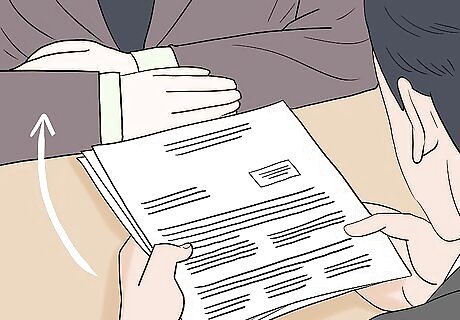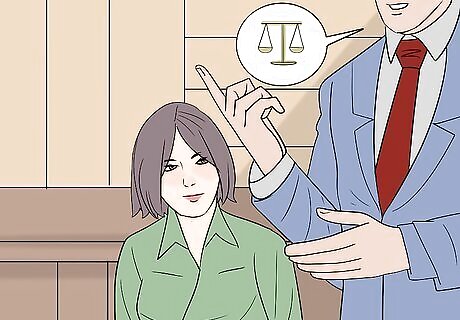
views
X
Trustworthy Source
Pine Tree Legal Association
Legal advocacy group providing public resources related to civil rights and and services and the justice system
Go to source
Reporting Criminal Harassment

Call 911 if an incident of harassment is in progress. If the person harassing you is threatening physical harm to you or someone you know or damaging your property, call 911 immediately. Give the operator your exact location and tell them what is going on. The 911 operator will make sure you are in a safe location and may stay on the phone with you until help arrives. As difficult as it can be in this situation, try to remain calm and give the 911 operator an exact location where you are. If you don't know the street address, describe the area with as much detail as possible so law enforcement can find you.

Gather evidence of the harassment. Even though your first instinct may be to throw things away as soon as possible, keep any letters, gifts, photos, or other items related to the harassment. These will help you prove your case to the police and give them leads to work with. If your harasser is calling you constantly, keep your call logs intact so police can see the number and frequency of calls. Save any voicemails or text messages.Tip: The laws in some states require you to prove at least 3 instances of behavior or an overall pattern of conduct before the person's behavior is considered harassment. Every piece of evidence is important.

Go to your local police or sheriff's department. If the incident has already ended, report the harassment in person at your local police or sheriff's department. Take any evidence you have of the harassment along with you. The officer who takes your statement may want to review it. If the officer doesn't give you a copy of the written police report immediately, ask when it will be available for you to pick up. If you can't get to the precinct in person, you can also call the non-emergency number and submit a report that way. The operator may send an officer to your location to take your statement or review any evidence you have.Tip: In some states, you are required to report the harassment to the police before you can take any other action, such as getting a restraining order or suing the person in civil court.

Get a copy of the written police report. You will likely need to return to the police or sheriff's department to get your copy of the written police report. Review the report carefully and make sure all the information in it is accurate. If you notice any mistakes, or if any important information was left out, tell an officer immediately so the report can be corrected.

Follow up with detectives or prosecutors as necessary. If the person continues to harass you, call back the officer who took your initial report and have the report updated to reflect this new information. If the police decide to investigate, you may also be contacted by a detective or prosecutor. If the prosecutor decides to charge the person harassing you with a crime, they will likely want to talk to you and go over the information you provided to police in your report.

Testify in court at the prosecutor's request. If your harasser is ultimately brought up on criminal charges and does not plead guilty, the prosecutor may want you to testify in court. This can be emotionally traumatic, but keep in mind you are never required to testify, no matter what the prosecutor might say. If you need or want protection, let the prosecutor know. For example, if you are only willing to testify if your harasser is not in the room, the prosecutor may be able to make that arrangement.
Getting a Restraining Order

Make copies of any documents that support your application. If you have documents, such as letters from your harasser, that are evidence of their behavior towards you, make copies that you can submit to the court along with your application for a restraining order. These documents can serve as evidence to prove your harasser's pattern of behavior towards you. If you reported your harasser to the police, you should also make a copy of any police reports you may have. If you have any digital documents, you can print those to include with your application. However, don't delete the original digital file. For online messages or text messages, you may want to take screenshots that you can print and include with your application for a restraining order.

Go to your nearest court and ask the clerk for an application. The clerk at your local courthouse will have an application you can fill out to apply for a restraining order. The restraining order will keep your harasser from contacting you or coming near you, your home, or anywhere you work or go to school. If your harasser violates the restraining order, you can call the police and they will be arrested. You may also be able to get a restraining order application at your local police or sheriff's department or at the office of a nonprofit organization that assists victims of abuse and harassment.

Fill out your application neatly and completely. Typically you'll need to fill out the application by hand. Print your answers neatly and legibly. Answer all the questions on the application as completely and honestly as possible. Don't write in the margins of the page – if you need additional sheets of paper to provide a complete answer to any questions, let the clerk know. Provide as many specific details as you can, including the specific dates and times of any contact and exactly what was said to you. If there was anyone else around who you know when an incident of harassment took place, include their names in your application. If you have evidence of any of the harasser's conduct, mention this specifically in your application.

File your documents with the clerk of court. Make two photocopies of your completed application, then take your original application, copy, and any other documents you want to file with it to the clerk's office. The clerk will file-stamp your original and copy and give a copy back to you for your records. The original is for the court files and the other copy will be delivered to your harasser. There is never a fee to file an application for a restraining order. The clerk may also have you fill out a summons to deliver to your harasser along with the application. Include as much information as you know. If you don't know your harasser's address, let the clerk know.Tip: In some courts, a judge will see you immediately after you file your documents. Wear clean, neat, professional clothing when you go to the clerk's office, just in case you have to appear before a judge.

Talk to a judge about your situation. After you file your application, a judge will ask you questions about the harassment you're experiencing. The judge will likely grant a temporary restraining order if you feel the person is an immediate and continuing threat to your physical and mental wellbeing. When you talk to the judge, always address them as "your honor." Although you'll probably be nervous, try to keep your voice calm and stick to the facts unless the judge specifically asks you about how the harasser makes you feel. Always answer the judge's questions honestly. If you don't know the answer to something, simply tell them you don't know. If it's necessary information, the judge may be able to help you locate resources that can help you.

Have the person harassing you served with the temporary order. After the judge issues the temporary order, your harasser must have notice of it so they can tell the judge their side of the story. Typically, a sheriff's deputy will take the papers to the person. If you don't know where the person can be found, let the clerk of court or the sheriff's deputy know. They can help locate the person.

Participate in the final hearing to make your temporary order permanent. Your harasser has the right to come to court and defend themselves. If you want to make your temporary order permanent, you'll have to go to a court hearing. Your harasser may be there, so it's a good idea to take a friend or family member along for moral support. Try to avoid looking at your harasser while in court for the hearing. Keep your eyes on the judge and always address the judge when speaking. If your harasser tries to talk to you, do your best to ignore them and avoid crosstalk. Once you have a permanent order, make copies of it and take it to all the places you frequent, such as your school or workplace. Make sure the person in charge of security or another administrator has a copy of it. If your harasser is not someone who is known to those people, you might also include a photo of the person so they'll know if they show up.
Filing a Civil Lawsuit

Talk to an attorney who specializes in civil harassment cases. Civil harassment cases can be very complex. If you decide you want to sue your harasser, it's generally best to hire an attorney who will represent you in court and draft all your documents for you. Many attorneys will take harassment cases on a contingency fee basis, which means you won't have to pay any attorney's fees unless you settle the case or win at trial. Depending on the reason you're being harassed, you may also be able to find an attorney at a nonprofit organization that is willing to represent you free of charge. For example, if you are being harassed because of your religion, you might look for a nonprofit organization that defends the right to freedom of religion.

Gather evidence of the harassment. You stand a better chance of proving harassment in a civil court than a criminal court because you don't have to prove beyond a reasonable doubt that the conduct occurred. Even if your evidence wouldn't be enough to get a criminal conviction, you may still be able to win in civil court. For example, if the person repeatedly sent you harassing text messages, you could use screenshots of those messages as evidence. You would also need to prove that the messages came from a phone that your harasser controlled and that they sent them (and not someone else). Your attorney will work on these details.

Collect evidence of the damage the harassment has caused you. Civil lawsuits are typically filed asking for money to cover the damage the person did to you. Regardless of whether your damage is physical or emotional, you still need evidence so you can put a price tag on how much that damage is worth. For example, if you are seeing a therapist to talk about your harasser and the emotional trauma they've caused, your therapist bills would be something you could potentially recover from your harasser. If you are taking anti-anxiety medication, the cost of that would also be part of your damages. If the person damaged your personal property in any way, repair bills or the cost to replace those items would also be considered damages. It can be hard to quantify something as vague as "pain and suffering," but think about how the harassment has affected you. For example, maybe you stopped participating in an activity because your harasser would always be there. That indicates a loss that you can put a price tag on. Lawyers are good at deciding how much these things might be worth.

Draft a complaint listing your allegations and damages. Once you have your evidence and damages together, you'll work with your attorney to compile a list of allegations against your harasser. These allegations go into your complaint, which gives the court (and your harasser) a summary of what you intend to prove in court. While complaints follow the same basic format, the actual substance of any complaint will vary depending on the facts of the case. Your complaint won't necessarily include every instance of harassment. Your attorney will choose the strongest allegations that they believe can be proven in court.

File your complaint with your local civil court. Once your complaint is done, your attorney will take it to the clerk's office and pay the filing fees to initiate your lawsuit. You'll get a file-stamped copy of your complaint back, which you'll need to keep. Filing fees for civil complaints vary greatly among different courts but typically are a few hundred dollars. If you've hired an attorney, they'll usually pay the court costs on your behalf when they file the lawsuit.

Have your harasser served with your complaint. Once your complaint is filed, it has to be delivered to your harasser. Typically this is done by a sheriff's deputy. If you don't have an address for your harasser, talk to your attorney. They'll have resources to locate the person. The sheriff's deputy typically charges a fee to serve a civil complaint. While the amount varies, it's usually less than $30. If you have an attorney, they'll pay this fee on your behalf.

Wait for your harasser to answer the complaint. Your harasser has a limited period of time after they're served with your complaint to file a written response – typically less than 30 days. If they don't file an answer, you may be eligible to win your case by default. Even in a default case, you typically still have to appear before the judge and prove that you are entitled to the specific amount of damages you claimed. For example, if you were claiming $10,000 in damages for therapy and medication, you would need to produce copies of bills that added up to $10,000 in expenses.

Work with your attorney to complete the discovery process. Assuming your harasser answers the lawsuit, the case enters discovery. You and your harasser will exchange evidence and ask each other questions about the case. In more complex cases, you may even hold depositions. This is when your harasser or a witness is asked questions under oath by your attorney. If your harasser has an attorney, they may want to depose you as well.Tip: At any point in time, your harasser may decide that it's in their best interest to settle the case. Most civil lawsuits settle before they ever get to trial.

Participate in a court hearing if the case has not settled. If your case is one of the rare ones that doesn't settle, a trial date will be set. On the day of the trial, you and your harasser will appear in court and present your cases to the judge. Your lawyer typically presents the bulk of your case. While you're expected to be there, you don't necessarily have to testify as a witness if you don't want to. Keep in mind that if you testify, that means your harasser (or their attorney, if they have one) will also be able to ask you questions.




















Comments
0 comment